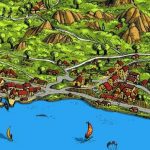Paths of stone, stories of life
Before the construction of the Strada Gardesana Orientale (1929), which today connects Peschiera to Riva del Garda along the coast, local people moved on foot through a network of ancient mule tracks carved into the mountains. These routes, used daily to connect villages and transport goods, were the beating heart of rural life for centuries.
With the “Baresola” among olive trees and oil mills
Farmers loaded freshly harvested olives onto wooden sleds called Baresole (or Barusole), pulled by donkeys or mules. The sleds would glide down the steep stone paths to the many village olive presses, where oil, once the area’s primary economic resource, was produced.
Roads of toil, marks in stone
Chestnuts, wood and hay were also transported on wooden sleds (caréte). To make it easier to slide on the pavement, the skids were greased with oil or lard scum. Even today, it is still visible the grooves dug over time by the sled and the iron hooks attached to the rock, used to slow its safe descent.
A heritage to be experienced
Today these mule tracks are still walkable and offer an authentic experience among olive groves, villages and forests, giving panoramic views and glimpses of ancient charm. Walking along these paths means immersing oneself in history, rediscovering the link between man, mountains and tradition.
Want to explore them?
Discover the trails on the interactive digital map of our territory, with routes, viewpoints and interesting facts:
👉 [Inserire QR code o link]
trails map















